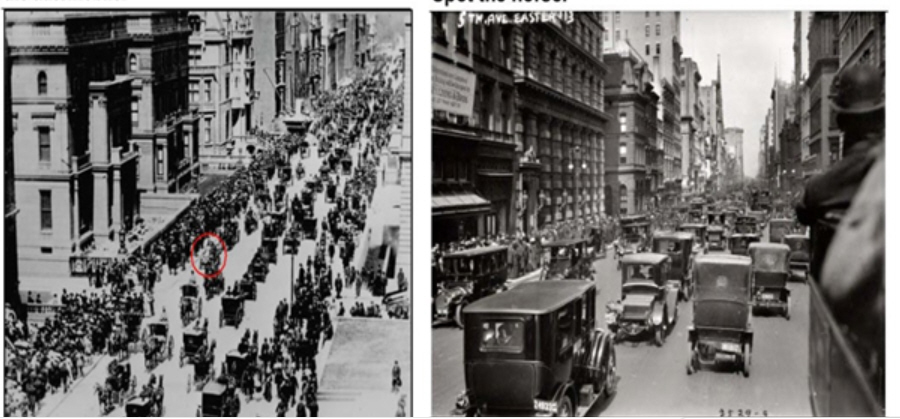

CST has a prediction. Within ten years major European cities will be transforming. There are two pictures from the 1920's of a change from horses to cars in Manhattan… Just 13 years between these two pictures. They show an amazing transformation – from all horse-drawn carriages to all motorised vehicles, not a horse & cart in sight. Such a transformation will soon be re-enacted within cities spanning the globe.

In the next ten years or so, European and other cities will go through a similar transformation. This time it will be from cars to driverless vehicles. So what? - But consider the consequences and the final result.
Let us first look at the current situation and likely trends. In the US, Google (Waymo) is already (March 2025) running standard driverless vehicles in several cities over wide city areas. In China, 19 cities have already been approved for this technology. The proverbial cat is out of the bag. Of course, it takes time for things to change, not necessarily due to technology but also due to acceptance, planning and provisioning.
In Europe, progress is also evident. Barcelona has successfully demonstrated autonomous mini-Buses on a 2.2-kilometre loop in its urban core. Valencia is preparing to launch a commercial service of Level 4 automated shuttles in July 2025. Zurich Airport has been evaluating autonomous solutions since January 2025. Additionally, Geneva and Oslo are set to deploy autonomous minibuses in 2025 as part of the ULTIMO project.
It is clear that we have already passed the green- light and this use of driverless vehicle tech will continue to expand across the world. The current thinking is moribund. Very few cities, people, governments or societies are seeing the true and substantial advantages of this coming change.
It will not be a change, it will be a transformation. When the public, businesses and the local governments see what is actually possible. Then the change will come very quickly as the benefits will drive this transformation relentlessly. So what are the benefits?
Let's take them one by one:
If you live in a city, you will not need to own or keep a car, this saves you money as it costs at least several thousand pounds a year even to own a small city car. Studies suggest savings could range from £3,000 to £5,000 annually for city dwellers.
Driverless taxis will be just a third or less of the price of a normal taxi. This aligns with projections from companies like Uber, Bolt and Lyft, who anticipate significant cost reductions with autonomous vehicles. Even if you take a taxi almost every day, the savings will still be in the thousands per annum.
The cost of owning a car for either city driving or for out of town driving will not make economic sense. Hiring an out of town vehicle when required will be a much cheaper option than owning a vehicle. So when you need a long-distance out of town car you will hire a vehicle designed for long distance. Unless you need to commute a long distance every day, it will be much cheaper and more efficient to use the driverless taxis.
The land gained from removing parked, city-based vehicles will transform cities. In cities like Bristol, this could free up space that will simply be transformational.
This land will be redistributed back to the city-based people for cycling, walking, running and green spaces. And it removes the hazards of parked cars for children aand pedestrians, (these vehicles currently sit parked on the street, mostly unused).
As driverless taxis, (or larger small bus-like units), will be made available almost immediately via an app, people will find their journey times much reduced. These taxis will be able to pick up several passengers on each leg and reduce the overall traffic density by a large factor. This means that the current road system will become much more efficient, cost-wise and time-wise.
As these vehicles become more adapted to this inner-city travel, this will continue to improve due to the number of occupants increasing and these vehicles will be much improved for inner-city travel, they will have more space for goods, beter headroom, easier access and maybe even a robot to carry your shopping to your door.
As the local roads become devoid of parked cars, the efficiency and safety of travel will become significantly improved. Studies suggest that autonomous systems may reduce traffic fatalities by up to 40% by eliminating human error.
The air quality within inner cities will improve tenfold – this, ultimately, CST believes will be one of the overriding driving forces of this transformation. Research indicates that shared autonomous vehicles and electrification could cut CO2 emissions by millions of metric tons per year in a city like Los Angeles, Bristol and Paris
By 2038 CST predicts that most inner cities across Europe will have a zero tolerance for any parked vehicles. This will move vehicle ownership to out of town parking and outlying areas.
Once a single European city shows the way forward – probably a complex European city like Bristol, Salamanca, Düsseldorf or Paris – the other cities will have to follow and quickly. The clamour for better air and the reclaimed space from the relief of parked cars will be significant. Local politicians will realise that they have to move and quickly.
After all it is a win, win. Everyone benefits, the local residents pay less for transport and travel becomes quicker. The out of town callers park their vehicles more easily and ride in a driverless taxi to their exact destination, probably cheaper than parking within the city centre. Tourists gain better, cheaper and easier access. Local residents have improved safety around their inner city properties and can use the available new space for walking, cycling, running and their children have less risk of being run down within the many rat runs within inner city areas.
CST has already done the planning. Some years ago we wrote to the Mayor of Bristol about such transformation. Of course, nothing happened, but as we shall see, the process will grind forward and then in 2040 we shall look back and wonder why it took so long to see the light.
CST
City Transformation
March 2025
Cities will soon change -
and we shall all be wondering why it took so long